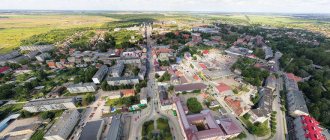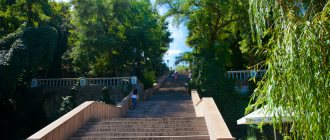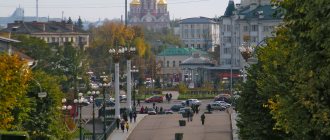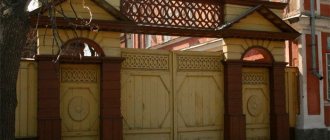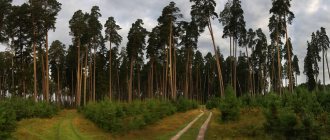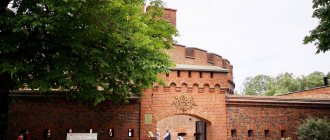Brandenburg Gate
One of the first attractions of Berlin that comes to mind when you think about the capital of Germany is the Brandenburg Gate. Throughout German history, the Brandenburg Gate has played a variety of roles and reflects the country's turbulent past and achievements like no other landmark in Germany. The gate served as the main entrance to Berlin, and is also a symbol of the division of the city into two parts, the Western and Eastern occupation zones for many years. The Brandenburg Gate was built in 1791 from sandstone.
Sights of Berlin: photos and descriptions
This article presents a rating of the best attractions in Berlin in 2022 with photos, names and descriptions in Russian. You will also find out what to see in Berlin in 1, 2 and 3 days, where to go on your own and with children, what to do in Berlin in the evening and see the sights of Berlin on the map.
Berlin can rightly be called the cultural capital of Germany. This is where the main attractions are collected, such as museums, galleries , cathedrals , ancient castles , theaters and much more. A walk through the well-groomed picturesque parks of Berlin will be remembered for a long time. It’s definitely worth taking a child on your trip, because in addition to the standard set of attractions, the little traveler will certainly enjoy one of amusement parks .
The architecture of the city is amazing: historical buildings give way to modern skyscrapers . We can safely say that it is hardly possible to get to know the capital of Germany in detail in a day with so many iconic places.
If you are in Berlin for the first time, then you should start your acquaintance by visiting the most important symbols of the city - the Reichstag building with a glass dome , the Brandenburg Gate and the remains of the Berlin Wall . “Checkpoint Charlie” is a border checkpoint on Friedrichstrasse, which became the scene of a historical tank confrontation.
Not far from Checkpoint Charlie and the Brandenburg Gate there is a completely non-trivial attraction - the Die Welt hot air balloon , without which the panorama of Berlin is quite difficult to imagine. On the balloon you can rise to a height of 150 meters and see Berlin in miniature.
History buffs flock to palaces and fortresses within the city to see the best historical complexes and their exhibitions.
Plötzensee prison museum is still used for its intended purpose. The memorial preserves the memory of the terrible events of the Third Reich, when over 3,000 people were executed within the walls of Plötzensee, among whom were Musa Jalil, Julius Fucik, Vera Obolenskaya and other famous personalities.
Berlin's main museums are concentrated on Museum Island , which has been under the auspices of UNESCO since 1999. The most interesting exhibition venues are the Bode Museum, the Old Museum, the New Museum with an exhibition of the Egyptian Museum, the Old National Gallery and the Pergamon Museum. Also on the island is the Berlin Cathedral and the Lustgarten park with a huge granite bowl - a favorite vacation spot for citizens and tourists.
More details: Berlin Museums
Berlin Zoo attracts thousands of tourists from all over the world. The Tiergarten is home to over 17,000 fauna. Zoo visitors especially enjoy participating in the process of feeding the animals.
Perhaps the only landmark of Berlin that can be seen from many areas of the city is the Berlin TV Tower . At the top of the tower there is an observation deck from where the whole of Berlin opens up in full view.
The posters of Berlin theaters are full of exciting events, and companies from all over the world delight avid theatergoers all year round. The largest and most modern theater stage in Berlin is the revue theater Friedrichstadtpalast , whose unique repertoire is the traditional cancan.
Reichstag
With the proclamation of the German Empire in the Hall of Mirrors at Versailles in 1871, Berlin became the capital of the empire and there was a need for a more prestigious building for the German government. The foundation stone for the new Reichstag, a huge neo-Renaissance palace, was laid by the Emperor himself in 1884. Construction was completed ten years later. After its destruction by fire in 1933, it was rebuilt in 1970, but with the decision to return governments to Berlin from Bonn following German reunification, the Reichstag underwent a complete renovation in the late 1990s.
Charlottenburg Palace
Charlottenburg Palace is an amazingly beautiful example of a Baroque building. The name of this Berlin landmark is associated with the order given by the wife of Frederick I, Queen Sophia Charlotte, to begin its construction. It was a summer royal residence, which gradually, during the course of work, turned into a huge building. Its scale is indicated by the 48-meter dome located above the main entrance. The center of the palace is considered to be the apartments of King Frederick I. The reception hall is also grandiose, the vaults of which are extremely high, and the walls are decorated with numerous niches and bas-reliefs.
Holocaust Memorial
Next to the Brandenburg Gate is the Holocaust Memorial, a tribute to the Jewish people for the extermination of Jews by the Nazis during World War II. 2,711 slabs are arranged in waves over 20,000 square meters. Each stone is unique.
At the base of the memorial there is an underground information center that provides information and personal stories of people affected by the Nazis. The memorial was designed by Daniel Libeskind and it leaves a lasting impression on visitors.
Wilhelm Kaiser Church
This temple was erected in memory of Wilhelm, who became the first Kaiser. The temple received serious damage from Allied bombing in 1943, only the western tower was partially preserved, the rest of the building was completely destroyed. After the end of the war, local residents insisted on not rebuilding the church, but not demolishing the ruins either. This landmark of Berlin was supposed to serve as a reminder of the events of the war. However, in the 60s, several modern buildings were built near the ruins, and a year later they were consecrated by church representatives. Instead of the main nave of the old temple, a bell tower 100 meters high was erected. There is a small souvenir shop there. Every week, on Sunday, organ concerts are held, which are quite popular among both visitors and local residents, who arrive in large numbers to listen to the musicians.
You have already voted
Berlin Wall (East Side Gallery)
A section of the original Berlin Wall has been dedicated as an art site and is now the largest open-air gallery in the world. The East Side Gallery is the longest, best preserved and most interesting section of the famous Berlin Wall, converted into an open-air gallery. The 1,300-meter-long gallery, running along the Spree River, reflects in a special artistic manner all the important political events that took place in Germany. On the wall hang works by artists from all over the world. This section of the wall is under state protection as an important historical monument.
The Berlin Wall once divided the city into East and West Berlin. After the fall of the wall in 1989, hundreds of artists from all over the world came to Berlin to transform the gloomy and gray wall into a work of art. They covered the eastern side of the wall, which had been untouched until then, with more than 100 images and it is now the largest open-air gallery in the world.
Official website: www.eastsidegallery.com
11. Tiergarten
Tigraten is a district of Berlin that is part of the Mitte district. In the modern world it appeared as a result of the administrative reform carried out in 2001. Informally, Tiergarten is considered the center of the city due to the presence of wooded alleys, parks and many other recreational areas, which is why a huge number of locals and tourists flock here. It is also here that Berlin's most iconic sights are located, including the Reichstag and the Embassy Quarter. These are the places worth visiting for tourists who arrived in the city for the first time.
Pool Badeshift
The unique Badeshift outdoor pool is a purely Berlin invention. It is built from an old barge frame and floats down the Spree River on its own. All visitors, in addition to swimming, are invited to enjoy the beautiful view that opens from here to the central streets of the eastern shore. The pool has a sandy beach and a wooden platform, which attract sun lovers on a fine day. At the same time, you won’t be bored: there is a bar nearby. Summer is the ideal time to visit the pool, which is open until late in the evening. In winter, it is covered with a special canopy, it is kept warm inside and there is a sauna.
Gendarmenmarkt
The Gendarmenmarkt is a large square in the city center. It is considered to be one of the most beautiful places in Berlin. The composition is formed from three significant landmarks: the Concert Hall in the center, the German Cathedral on the right, the French Cathedral on the left. Here you will find many cozy cafes where you can have leisurely conversations. The perfect proportions of the local buildings create a special atmosphere, making it an ideal place for a stroll. You can also do some shopping here, since the square has a huge number of shops with a wide variety of products. The Gendarmenmarkt owes its name to the elite of the Prussian cavalry - the gendarmes. In 1736, stables belonging to the cuirassier regiment were built on this site.
Spandau Citadel
Spandau Citadel
Spandau Citadel is a fortress located in the northwestern part of Berlin on the banks of the Havel River. This is one of the most significant and well-preserved Renaissance fortresses in Europe.
The citadel was built between 1559 and 1594 on the site of a medieval fortress in the city of Spandau, which is now one of the 12 administrative districts of Berlin.
The architects of the citadel were the Italian Francesco Chiaramella de Gandino, and the Italian Rocco Di Linari, who replaced him in 1578.
In addition to its main function as a fortified defensive structure, at various times the Spandau citadel housed military production, a laboratory for chemical defenses and toxic substances for the army, and a local history museum.
Currently, the City Historical Museum of Military Weapons is open here.
Opening hours of Spandau Citadel
Opening hours of the Spandau Citadel - from 10-00 to 17-00
Cost of visiting Spandau Citadel
Tickets to the Spandau Citadel cost €4.50 for adults and €2.50 for children 6-14 years old.
The official website of the Spandau Citadel, where you can find up-to-date information on opening hours and cost of visiting.
How to get to the Spandau Citadel The Spandau Citadel is located at the U7 - Zitadelle metro station or the S5 - Spandau train station.
Boulevard Unter den Linden
This Boulevard is also one of Berlin's landmarks . Unter den Linden in German means under Lipami. The linden trees were planted by order of Friedrif Wilheln in 1647. He traveled along this road from the palace to Tiergarten, where his hunting grounds were located. Now there is a park in these places. In 1770, this road underwent a change; by order of Frederick II, the old houses were demolished, there were 44 of them, and mansions and houses for wealthy citizens . The old dusty road has acquired a noble appearance. The linden trees were cut down during construction and planted again at the beginning of the 19th century. The boulevard starts from Paris Square and ends at the bridge over the Spree River, this bridge is called the Palace Bridge. The length of the boulevard is 1390 m with a width of 60 m. Shopping lovers will also like the Unter den Linden boulevard because there are many shops and boutiques .

